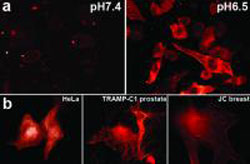Targeted drug delivery now possible with ’pHLIP’ peptide

The delivery of fluorescent phalloidin into cells by pHLIP. (a) HeLa cells at pH 7.4 (Left) shows weak label localized at the cell membrane, and pH 6.5 (Right) shows fluorescent actin filaments inside cells. (b) HeLa (Left), breast cancer (Center), and prostate cancer (Right) cells show different and characteristic patterns of fluorescent actin filaments. Credit: Credit: Yale University
Their “cargo carrier” peptide called pHLIP, for pH (Low) Insertion Peptide, accumulates in the membranes of cells in acidic environments and spontaneously transfers attached molecules across the membrane. The cargo is then released by cleavage of a sulfur-sulfur bond that is only unstable if it is inside the cell. The study, published early online in the Proceedings of the National Academy of Sciences, was led by Donald M. Engelman, professor of molecular biophysics and biochemistry at Yale.
“Our system offers a new technology for the fast and efficient delivery of drugs, imaging probes, or cell and gene regulation agents into living cells,” said Engelman. “pHLIP may provide a new approach for imaging, diagnosis and treatment of diseases with naturally occurring or artificially created low-pH extracellular environments, such as tumors, infarcts, stroke-afflicted tissue, atherosclerotic lesions, sites of inflammation or infection, or damaged tissue resulting from trauma.”
Normal cells are surrounded by an environment with a constant pH of about 7.4, while tumor cells and sites of inflammation actively pump protons out and create an acid extracellular pH of 5.5 to 6.5.
The study shows that pHLIP entry into the cell membrane and the translocation of molecules into cells are not mediated by the usual entry pathways — endocytosis, interactions with cell receptors, or by formation of pores in cell membranes.
“By translocating a molecule into a cell and releasing it in the cytoplasm, pHLIP functions, in effect, as a nanosyringe,” according to Engelman. “The peptide does not exhibit any of this structure in solution or on the cell membrane at neutral pH. However, at low pH it becomes rigid like a syringe needle, inserts into a cell membrane, and injects molecules into cells.
Drug or dye molecules can be linked by sulfur-sulfur bonds to pHLIP. This paper demonstrates the effectiveness of pHLIP with a cargo of fluorescently tagged phalloidin, a toxin from the deadly Amanita phalloides mushroom that normally cannot enter cells. Inside the cells phalloidin binds to actin molecules and “freezes” the cellular skeleton giving a distinct visual pattern under the microscope.
Media Contact
All latest news from the category: Life Sciences and Chemistry
Articles and reports from the Life Sciences and chemistry area deal with applied and basic research into modern biology, chemistry and human medicine.
Valuable information can be found on a range of life sciences fields including bacteriology, biochemistry, bionics, bioinformatics, biophysics, biotechnology, genetics, geobotany, human biology, marine biology, microbiology, molecular biology, cellular biology, zoology, bioinorganic chemistry, microchemistry and environmental chemistry.
Newest articles

Biophysics: Testing how well biomarkers work
LMU researchers have developed a method to determine how reliably target proteins can be labeled using super-resolution fluorescence microscopy. Modern microscopy techniques make it possible to examine the inner workings…

Making diamonds at ambient pressure
Scientists develop novel liquid metal alloy system to synthesize diamond under moderate conditions. Did you know that 99% of synthetic diamonds are currently produced using high-pressure and high-temperature (HPHT) methods?[2]…

Eruption of mega-magnetic star lights up nearby galaxy
Thanks to ESA satellites, an international team including UNIGE researchers has detected a giant eruption coming from a magnetar, an extremely magnetic neutron star. While ESA’s satellite INTEGRAL was observing…





















